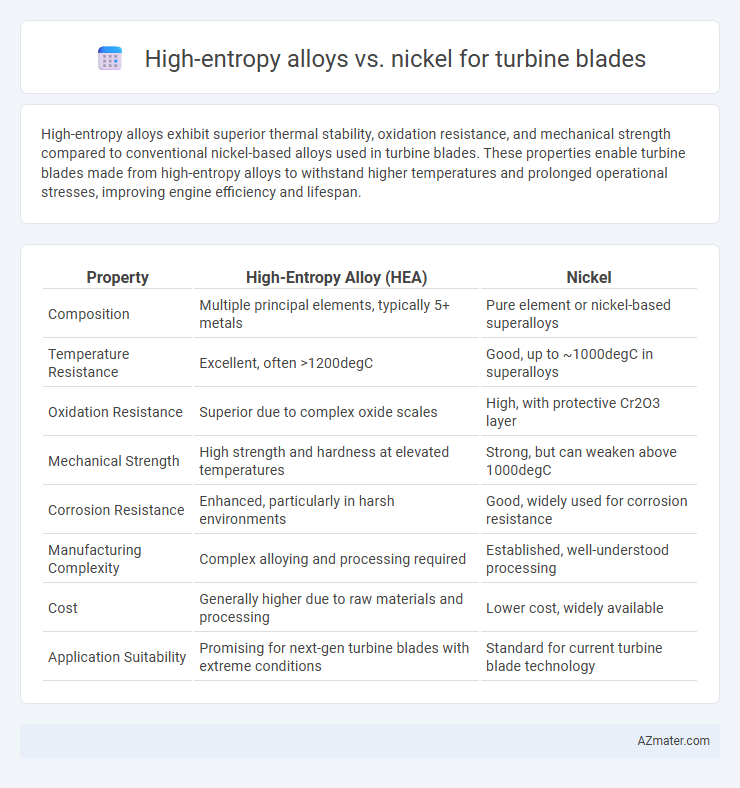High-entropy alloys exhibit superior thermal stability, oxidation resistance, and mechanical strength compared to conventional nickel-based alloys used in turbine blades. These properties enable turbine blades made from high-entropy alloys to withstand higher temperatures and prolonged operational stresses, improving engine efficiency and lifespan.
Table of Comparison
| Property | High-Entropy Alloy (HEA) | Nickel |
|---|---|---|
| Composition | Multiple principal elements, typically 5+ metals | Pure element or nickel-based superalloys |
| Temperature Resistance | Excellent, often >1200degC | Good, up to ~1000degC in superalloys |
| Oxidation Resistance | Superior due to complex oxide scales | High, with protective Cr2O3 layer |
| Mechanical Strength | High strength and hardness at elevated temperatures | Strong, but can weaken above 1000degC |
| Corrosion Resistance | Enhanced, particularly in harsh environments | Good, widely used for corrosion resistance |
| Manufacturing Complexity | Complex alloying and processing required | Established, well-understood processing |
| Cost | Generally higher due to raw materials and processing | Lower cost, widely available |
| Application Suitability | Promising for next-gen turbine blades with extreme conditions | Standard for current turbine blade technology |
Introduction to Turbine Blade Materials
Turbine blade materials demand exceptional mechanical strength, corrosion resistance, and thermal stability to withstand extreme operating conditions. High-entropy alloys (HEAs) exhibit superior structural properties and oxidation resistance compared to traditional nickel-based superalloys, which have long been the industry standard for turbine blades. Innovations in HEA compositions enable tailored performance enhancements, potentially revolutionizing the durability and efficiency of turbine blades in aerospace and power generation applications.
Overview of High-Entropy Alloys (HEAs)
High-Entropy Alloys (HEAs) consist of five or more principal elements mixed in near-equal atomic ratios, resulting in unique microstructures and exceptional mechanical properties such as high strength, thermal stability, and corrosion resistance. Unlike traditional nickel-based superalloys used in turbine blades, HEAs exhibit enhanced phase stability at elevated temperatures, which is critical for improving turbine efficiency and lifespan. Research indicates HEAs can potentially surpass nickel alloys in creep resistance and oxidation performance under extreme operating conditions.
Properties of Nickel-Based Superalloys
Nickel-based superalloys exhibit exceptional high-temperature strength, oxidation resistance, and creep resistance, making them ideal for turbine blade applications. High-entropy alloys offer promising mechanical properties and thermal stability but currently lack the extensive performance track record of nickel-based superalloys under extreme turbine operating conditions. The well-established microstructural stability and phase composition of nickel superalloys continue to provide superior durability and efficiency in high-stress, high-temperature turbine environments.
Mechanical Strength: HEAs vs Nickel Alloys
High-entropy alloys (HEAs) exhibit superior mechanical strength and high-temperature stability compared to traditional nickel-based superalloys, making them promising materials for turbine blade applications. HEAs possess a unique multi-principal element composition that enhances their yield strength, creep resistance, and fatigue life under extreme thermal and mechanical loads. Nickel alloys, while well-established for turbine blades, often face limitations in phase stability and strength retention at ultra-high temperatures where HEAs maintain structural integrity.
Creep and Fatigue Resistance Comparison
High-entropy alloys (HEAs) demonstrate superior creep resistance compared to conventional nickel-based superalloys due to their complex, multi-principal element composition that stabilizes microstructures at elevated temperatures. Fatigue resistance in HEAs is enhanced by their phase stability and lattice distortion, which reduce dislocation motion and crack propagation under cyclic loading. Nickel alloys, while renowned for high-temperature strength, often exhibit lower creep and fatigue resistance than HEAs when exposed to extreme operational environments in turbine blades.
Oxidation and Corrosion Resistance
High-entropy alloys (HEAs) demonstrate superior oxidation and corrosion resistance compared to conventional nickel-based superalloys used in turbine blades due to their complex, multi-element compositions that form stable, protective oxide layers at elevated temperatures. The high configurational entropy in HEAs enhances the formation of dense oxides such as Al2O3 and Cr2O3, which effectively prevent oxygen diffusion and improve durability in oxidative and corrosive environments. In contrast, nickel alloys rely heavily on specific alloying elements like chromium and aluminum, which can limit their long-term stability under extreme operational conditions.
High-Temperature Performance and Stability
High-entropy alloys (HEAs) exhibit superior high-temperature performance and stability compared to traditional nickel-based superalloys used in turbine blades, offering enhanced oxidation resistance and creep strength at temperatures exceeding 1100degC. The complex multi-principal element composition of HEAs stabilizes their microstructure, reducing phase degradation and grain boundary weakening during prolonged thermal exposure. This improved thermal stability and mechanical robustness position HEAs as promising materials for next-generation turbine blades operating in harsher environments.
Manufacturing Challenges and Processes
High-entropy alloys (HEAs) present complex manufacturing challenges for turbine blades due to their multiple principal elements requiring precise control of composition and microstructure during processes like casting and powder metallurgy. In contrast, nickel-based superalloys benefit from well-established manufacturing techniques such as directional solidification and single-crystal growth that optimize thermal and mechanical properties. Process optimization for HEAs remains critical to achieving uniform phase distribution and minimizing defects to rival the performance and reliability of traditional nickel alloys in high-temperature turbine applications.
Cost and Industrial Feasibility
High-entropy alloys (HEAs) offer superior high-temperature strength and corrosion resistance compared to traditional nickel-based superalloys, potentially enhancing turbine blade lifespan and performance. However, the current production costs of HEAs are substantially higher due to complex multi-element processing and limited large-scale manufacturing infrastructure. Industrial feasibility remains constrained as established nickel superalloy technologies dominate with optimized supply chains and proven cost-effectiveness in turbine blade fabrication.
Future Trends in Turbine Blade Materials
High-entropy alloys (HEAs) exhibit superior high-temperature strength, oxidation resistance, and phase stability compared to traditional nickel-based superalloys, making them promising candidates for next-generation turbine blade materials. Research trends emphasize the development of HEAs with tailored microstructures to enhance creep resistance and thermal fatigue life under extreme operating conditions. Advances in additive manufacturing and computational alloy design are accelerating the optimization of HEAs, potentially surpassing nickel alloys in efficiency and durability for future turbine engine applications.

Infographic: High-entropy alloy vs Nickel for Turbine Blade
 azmater.com
azmater.com